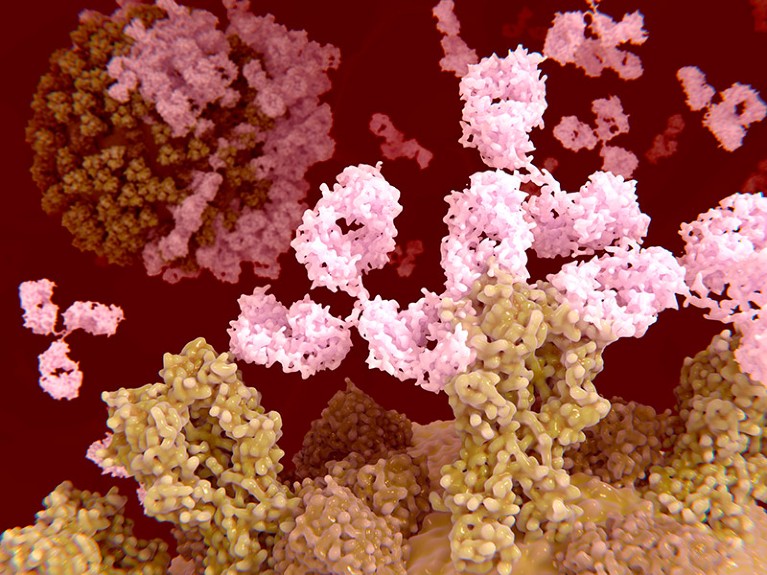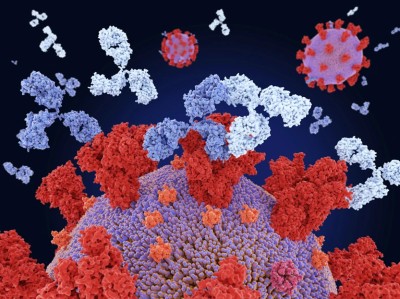[ad_1]

Antibodies (pink) bind to influenza virus proteins (yellow) (artist’s conception).Credit score: Juan Gaertner/Science Picture Library
Researchers have used generative synthetic intelligence (AI) to assist them make utterly new antibodies for the primary time.
The proof-of-principle work, reported this week in a preprint on bioRxiv1, raises the potential of bringing AI-guided protein design to the therapeutic antibody market, which is price lots of of billions of {dollars}. The work has not but been peer reviewed.

AlphaFold touted as subsequent massive factor for drug discovery — however is it?
Antibodies — immune molecules that strongly connect to proteins implicated in illness — have conventionally been made utilizing brute-force approaches that contain immunizing animals or screening huge numbers of molecules.
AI instruments that may shortcut these pricey efforts have the potential to “democratize the flexibility to design antibodies”, says examine co-author Nathaniel Bennett, a computational biochemist on the College of Washington in Seattle. “Ten years from now, that is how we’re going to be designing antibodies.”
“It’s a extremely promising piece of analysis” that represents an essential step in making use of AI protein-design instruments to creating new antibodies, says Charlotte Deane, an immuno-informatician on the College of Oxford, UK.
Making mini proteins
Bennett and his colleagues used an AI device that their crew launched final yr2 that has helped to rework protein design. The device, referred to as RFdiffusion, permits researchers to design mini proteins that may strongly connect to a different protein of alternative. However these customized proteins bear no resemblance to antibodies, which acknowledge their targets by means of floppy loops which have proved tough to mannequin with AI.
To beat this, a crew co-led by computational biophysicist David Baker and computational biochemist Joseph Watson, each on the College of Washington, modified RFdiffusion. The device is predicated on a neural community just like these utilized by image-generating AIs comparable to Midjourney and DALL·E. The crew fine-tuned the community by coaching it on hundreds of experimentally decided buildings of antibodies connected to their targets, in addition to real-world examples of different antibody-like interactions.

How generative AI is constructing higher antibodies
Utilizing this strategy, the researchers designed hundreds of antibodies that acknowledge particular areas of a number of bacterial and viral proteins — together with people who the SARS-CoV-2 and influenza viruses use to invade cells — and a most cancers drug goal. They then made a subset of their designs within the laboratory and examined whether or not the molecules might bind to the correct targets.
Watson says that about one in 100 antibody designs labored as hoped — a decrease success price than the crew can obtain with different varieties of AI-designed protein. The researchers decided the construction of one of many influenza antibodies, utilizing a method referred to as cryo-electron microscopy, and located that it acknowledged the supposed portion of the goal protein.
Early proof of precept
A handful of corporations are already utilizing generative AI to assist develop antibody medication. Baker and Watson’s crew hopes that RFdiffusion can assist to deal with drug targets which have proved difficult, comparable to G-protein coupled receptors — membrane proteins that assist to manage a cell’s responses to exterior chemical compounds.
However the antibodies that RFdiffusion churned out are a good distance from reaching the clinic. The designer antibodies that did work didn’t bind to their targets significantly strongly. And any antibody used therapeutically would wish its sequences modified to resemble pure human antibodies in order to not provoke an immune response.
The designs are additionally what’s often known as single-domain antibodies, which resemble these present in camels and sharks, slightly than the extra advanced proteins that just about all accredited antibody medication are based mostly on. A lot of these antibody are simpler to design and less complicated to review within the lab, and it is smart to design these first, says Deane. “However this doesn’t take away from it being a step on the best way to the sorts of strategies we want.”
“That is proof-of-principle work,” Watson stresses. However he hopes this preliminary success will pave the best way for the design of antibody medication at contact of a button. “It seems like fairly a landmark second. It actually reveals that is attainable.”
[ad_2]
Supply hyperlink



